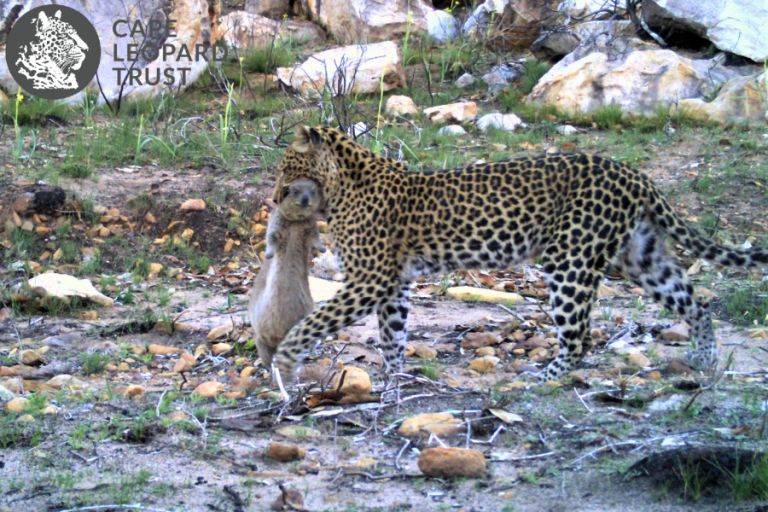Humans have undeniably had a severe impact on Earth’s biodiversity and climate. However, as a species, we also have an undeniable responsibility toward and role to play in the mitigation and solution-finding process. In order to solve a problem, one needs to understand the variables contributing to the problem.
Globally, the major threats to leopards are human-related – habitat loss & fragmentation, depletion of natural prey, hunting for the skin trade, direct conflict with humans (both in agricultural & urban settings). It is no different for the leopard population in the Cape Fold Mountains of the Western Cape. Last July we introduced our current research focus of identifying direct and indirect human-related threats to leopard along the edge of the southern section of the north-south axis of the Cape Fold Mountains. We were driven by the question: “What are the specific threats to leopards locally?”
Students Wian Nieman and Brittany Schultz conducted structured interviews on 103 properties bordering on Protected Areas within the study area. They interviewed the owner or manager of each property as well as 307 labourers collectively. They collected data on the use of illegal wire snares; legal hunting for management purposes on private property; the presence of feral dogs and their interactions with wildlife, as well as perceived changes in animal abundance and distribution.

Image caption: A map of the study are indicating the 103 properties
taking part in the structured research questionnaire.
Wian’s study serves as the first demonstration of a large number of factors influencing wire-snare poaching patterns in the Boland study area. The novel and valuable information generated by this data collection and analyses are set to provide local conservation managers and policy makers with baseline off-take data pertinent to the effective management of a multifaceted threat affecting native wildlife populations. Preliminary results indicate that the issue is complex and a number of property features and socio-economic attributes influence the incidence of illegal wire snares: amongst others the proximity to Protected Areas, to major roadways and to residential areas; family size; economic status; and adequacy of anti-snaring regulations.
Of the 307 interviewed labourers, 13.7% admitted to regular involvement in snaring activity. Small antelope (duiker, grysbok, klipspringer), porcupine and guinea-fowl were the species most frequently caught in wire-snares. A crude hypothetical extrapolation from those numbers starts pointing towards a potentially massive problem: If those 42 people each capture only 1 duiker every 3 months – it amounts to 168 duikers per year. 13.7% may not sound like a high percentage, but considering that the total number of labourers working around the Boland area is many many more than 307, the numbers of small mammals caught annually in snares could be staggering.
It is significant to note that the main prey species representing ~80% of relative biomass consumed in a sample of 173 leopard scats from in the Boland region of the Cape Fold Mountains are klipspringer (23.9%), rock hyrax (20.1%), grysbok (19.7%) and porcupine (16.3%). It is therefore clear that unsustainable off-take of these species along the edges of Protected Areas may have a profound depression effect on prey populations, and may thus negatively impact leopard numbers.

Image caption: Leopards are opportunistic hunters with a broad diet.
This graph shows the proportions in terms of biomass consumed of different prey species
identified in a sample of 173 leopard scats from the Boland study area.
But, our impact is not only on the leopards’ food. We’re also impacting their “home”. A dramatic loss in range (28-51% less than historical Southern African range) and the decline in numbers are reported for leopards right across their global distribution. In the Western Cape, only 30% of suitable leopard habitat is formally protected – which means that 70% of suitable leopard habitat is on privately owned properties.
The core mountainous habitat in the Boland study area is preserved due to its status as a Protected Area, however edges (or fringe habitat), mostly on private property, are heavily impacted by habitat alteration and growing human peripheral activities. Brittany’s study brings into focus human-related habitat and biodiversity changes over the last three decades: a) land-use changes, habitat loss and urbanisation over the past 30 years, b) wildfire frequency and its extent over the past 30 years, c) long-term mammal species abundance and distribution trends, d) the extent, origin and reported wildlife interaction of free-roaming and feral dogs in the study area.
New knowledge and an understanding of previously unstudied factors and processes may well have a profound effect on the long-term survival of leopards and their prey in the region.
This research project is funded by grants from
Hans Hoheisen Charitable Trust managed by Nedbank Private Wealth
Wilderness Foundation Africa: Forever Wild Leopard Conservation Initiative

















